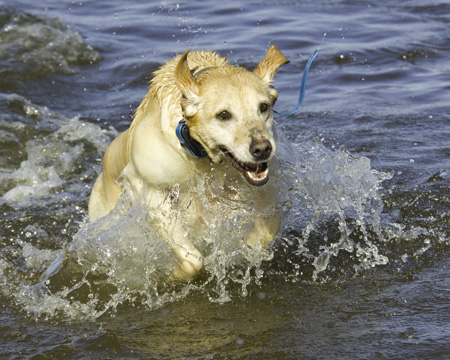For action photos, the most important considerations in selecting a camera are:
Shutter lag: the time between when you press the button and when the camera actually takes the picture. For high end cameras this will be about .05 seconds. For lower end cameras it may be .5 seconds. The difference is huge. At .5 seconds the shot you get has nothing to do with the shot you tried to take in an action situation.
Shots per second: How many sequential shots can you take per second and how many before the camera has to slow down to write the images to the memory card? Higher end cameras will shoot 4-8 shots/second at maximum resolution and allow you to shoot 10-20 shots before slowing down. This improves your chances of getting lucky in capturing that magic moment.
Time to Focus/Accuracy of Focus: Higher end cameras have very precise and fast auto-focus capabilities and allow you to pick what part of the image in the viewfinder will be used to focus on. However, you only get the full benefit of this capability with a high end lens that is capable of being focused quickly. Without a quick auto-focus, you must effectively pick the spot where you will shoot your picture and wait for the dog to run through it while keeping the camera on manual focus. You can improve your odds of a good focus by taking shots from the side of the running dog so the distance remains relatively constant rather from directly in front where the distance is changing quickly.
Lens Quality: When you pick a camera body you are also picking the lens family that you will have to live with. For action photography, you need a good selection of high resolution, fast, auto-focus and image stabilized telephoto lenses. Only two manufacturers are competitive at this level: Canon and Nikon. Unfortunately, competitive is defined by quality, not cost. Both are extremely expensive with even their "better" (not best) telephotos in the 200-400 mm range costing over $1000 with image stabilization and fast auto-focus capability.
Having said all this, the reality is that great pictures can be taken with almost any camera -- it just requires a little more luck. Also, most of us are happy with good pictures and incapable of taking great pictures consistently anyway. Professional photographers use the best equipment because they must be able to take very good to great shots on a predictable basis. If someone asks you to take pictures of their dog in a trial,they won't be happy if you ask them to run the dog again since you missed the shot.
Almost all professionals using 35 mm style SLR cameras use either Canon or Nikon. Canon probably has a slight advantage for "still" shots (weddings, fashion, landscape). Nikon has an advantage among photo-journalists shooting action shots. You can see this simply by looking down the sidelines of a pro football or basketball game. As you look at those long lenses, however, remember that the starting price for a high quality 400 mm+ lens is $5000+ and they range to about $10,000. The camera bodies that go with them range from about $1500-$5000.
These images were all taken with a Nikon D2X camera using either the Nikon 70-200 mm f/2.8 AF-S VR lens or the Nikon 80-400 mm f/4.505.6 AF VR lens.








